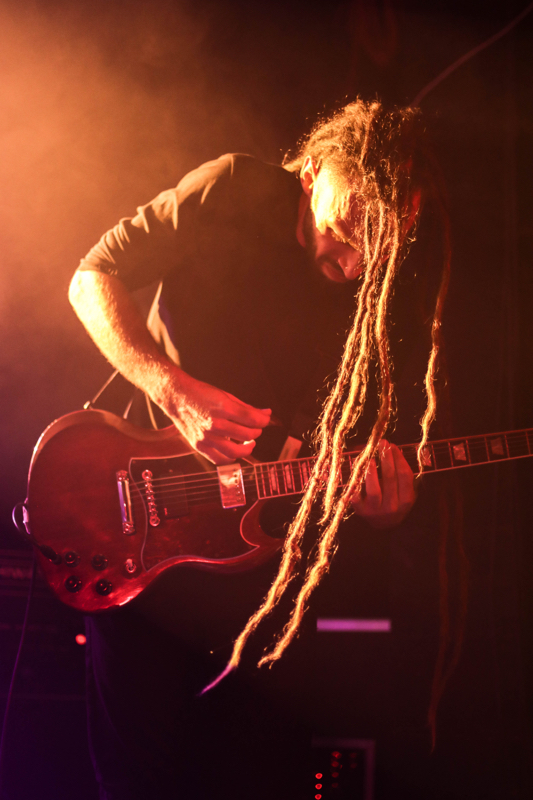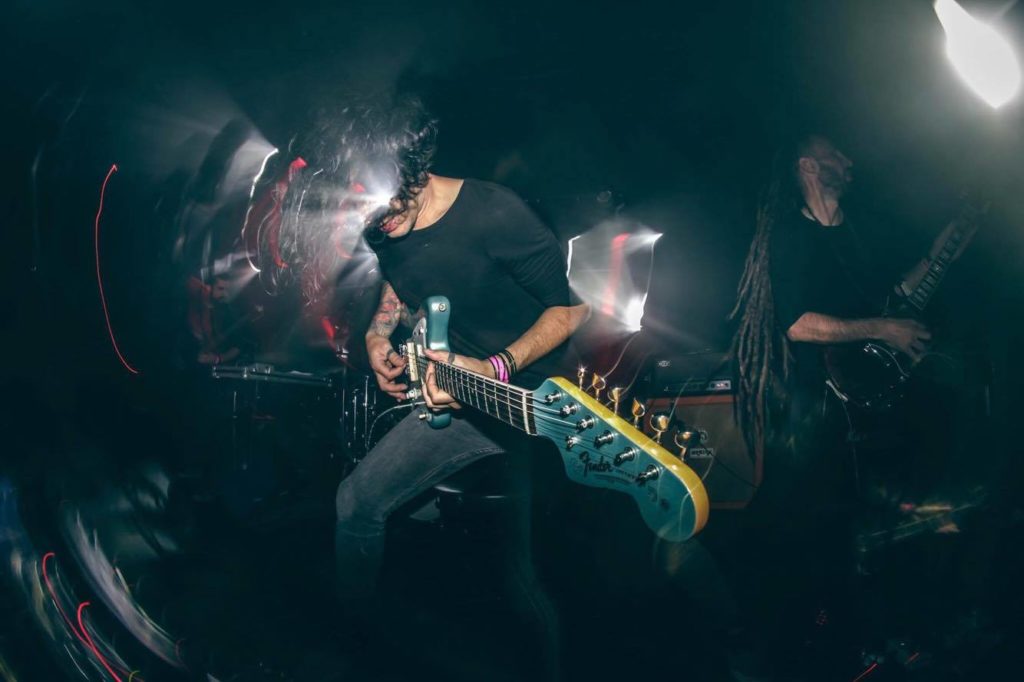The release of BLAK’s debut album “Between Darkness And Light” was one of Elusive Sound’s highlights of 2017. BLAK’s drummer Carles P.D. wrote a track-by-track published by KAOM that the band later posted in five parts on Facebook, detailing the band’s approach to the concept behind each song, all now compiled here as one. Our thanks to Biken Ros. All photos taken at Amfest by Sergi Vila and by Abel Cruz for QRO Magazine.
IDEAS BETWEEN DARKNESS AND LIGHT: an approach to the concept behind each song
Part I, “In the absence of light – Eigengrau”
Eigengrau is «the dark gray color seen by the eyes in the absence of light». It is a sensation that we experience continuously and that at the same time goes unnoticed because we do not give it a name. As soon as we came across the word we realized that it linked with the cover’s sketch and our compositions, which combined dark fragments with softer ones, as if they were a succession of colors. We began to sense that light could work as the central element of the album. This light had to have a meaning beyond the mere physical phenomenon, and that’s why we also needed it in its metaphorical meaning which means to show, and more specifically, to teach. Thus, the record began to revolve around learning, discovery and about absolute truth and subjective perception, represented by the way everyone perceives colors. “In the absence of light” was perfect for us to open the record and raise the question of what remains when there is no light. It’s not black and it’s not just ignorance. To experience it you just must close your eyes. So, imagine the song in a single blinking, slowly closing your eyes until you reach the eigengrau color, which is the moment when the music intensifies.

Part II, “Impression of an even deeper darkness — Illusion”
The title of this song is a phrase from the book “Atonement” by Ian McEwan, in which a girl watches a bunch of flies flying around a light and remembers having read that the insects approach the light looking for a darkness that is supposedly behind it. The phrase captivated me and I stored it in my memory and when we were naming our songs it seemed to me that it tied with the subject of the album. The first reason was that the song is the most violent of all the record and it comes after the light from the first, so I wanted to describe a darkness similar to that generated in a storm. Secondly, there is a conceptual factor linked to the thoughts of the girl, who asks herself how someone can know what happens inside an insect’s head, and doubts on what has been read. I consider this darkness that supposedly insects seek as the absolute truth that some people believe they can find and that makes them insects flying around like those in the book.

Part III, “Temples drawn by the blind — Revelation”
«First I drew a box that looked like a hose. It could have been the house I lived in. Then I put a roof on it. At either end of the roof, I drew spires. Crazy.»
In “Cathedral”, Raymond Carver describes how a blind man asks a young man to take his hand and together draw a cathedral. This seemingly banal gesture becomes a revelation for the young man, who before meeting with the blind person only thought about the discomfort he would feel during this forced meeting. While tracing the forms of the building, the young man experiences a series of new emotions and realizes that the blind person, from whom he felt sorry, is the one who is really teaching him how to create a building from scratch. It is not by chance that the object drawn is a cathedral, a symbol of faith. In this case it is not a religious faith, but everything that the world offers and that the young person refuses the possibility of admiring. For the title of the song we used the term “temple” because it has the same metaphorical component the tale speaks of. We were interested in the construction of ideas from the dark, from the void, like the song, which begins with a simple base on which the composition is edifying, which rises as the construction of a temple.

Part IV, “Black drips in the sky — Overwhelming”
This song was born from a fragment that reminded me of “Hombre araña”, by Standstill, and that’s why I insisted on developing it. I have always thought of it as a liquid song; the floor tom at the beginning makes me think of droplets falling on a surface and, some fragments, on running water. The melody also seems overwhelming in the sense that it has a magnitude that surrounds me and since the relationship between drops, liquids and colors became evident in painting, I began to think about paintings that could relate to the song . That’s how I came to the series “Blau” by Joan Miró. They are three huge blue paintings with black spots in the middle. I had seen them at an exhibition near my house, and I remember how they made me feel small. Curiously, when Miró talked about this series, he explained that the greatness of the sky had captivated and influenced him when it came to thinking about the series and I imagined this floor tom causing these black spots in the middle of a big blue. From here, the black drips in the sky.

Part V, “Colors awake — Perception”
“Colors move” is an extraordinary song by the Fuck Buttons and the culprit that at some point I imagined the colors coming alive, as if they had a will. Starting from here, I wanted to imagine that the phenomenon that causes the colors, that is the mixture of light with the perception of the eyes, actually depended on the same colors, as if they were the ones that decided to reveal themselves and appear before us. The song is slow and advances unfailingly towards its end, which would be the awakening. I can imagine a slow awakening, such as the color movement in the mosque of Nasir el Molk, in Shiraz, which depends on the movement of the Earth. It is a titanic movement, slow and unstoppable. A movement described in a poem written for the song, which begins:
They’re sleeping, waiting
for the light to reveal
Or this was just an excuse to share this amazing song.

